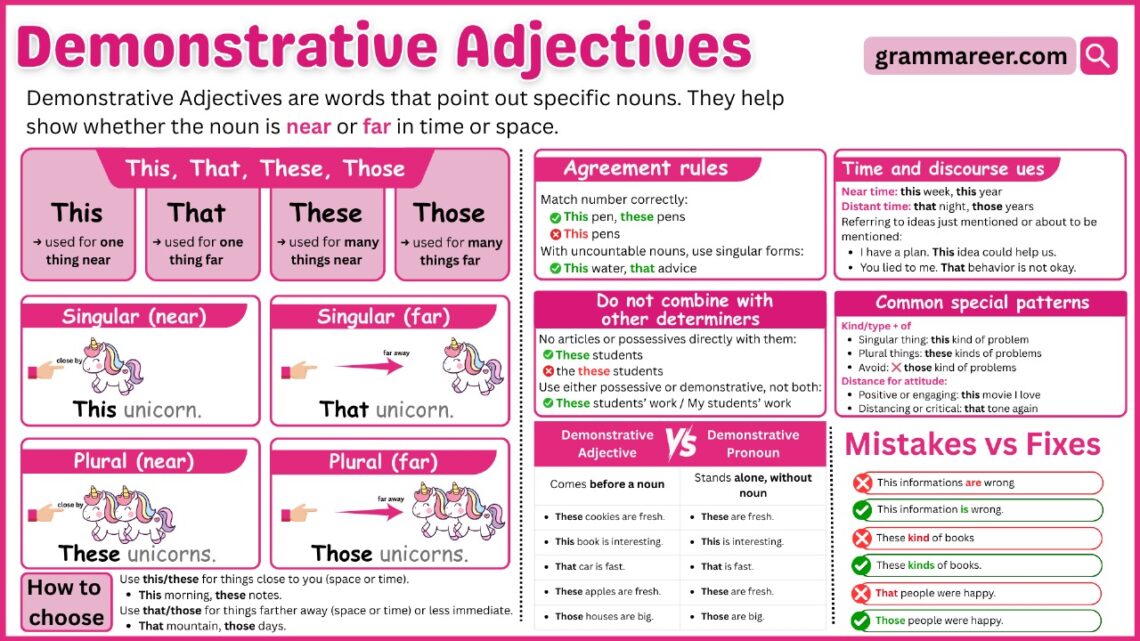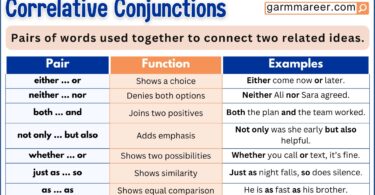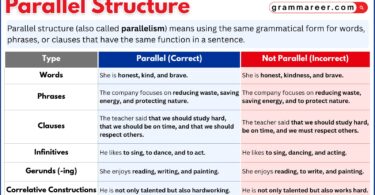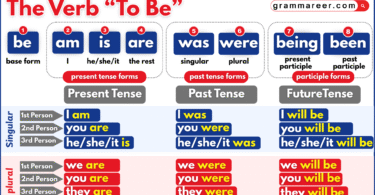Have you ever noticed how often you say words like this, that, these, or those? These are called demonstrative adjectives, and they help us point to specific nouns while showing whether they are near or far, singular or plural. They may be small words, but they play a big role in making our sentences clear and direct.
In this article, we’ll explore what demonstrative adjectives are, how they’re different from demonstrative pronouns, and how to use them naturally in everyday English. With simple explanations and examples, you’ll see just how easy it is to master these essential words.
Table of Contents
What is a demonstrative adjective?
A demonstrative adjective is a word (this, that, these, those) used before a noun to point out which specific thing we are talking about. It shows two things: number (singular or plural) and distance (near or far).
Examples:
- This book is on the table. (singular + near)
- That car looks fast. (singular + far)
- These apples taste sweet. (plural + near)
- Those stars look beautiful tonight. (plural + far)
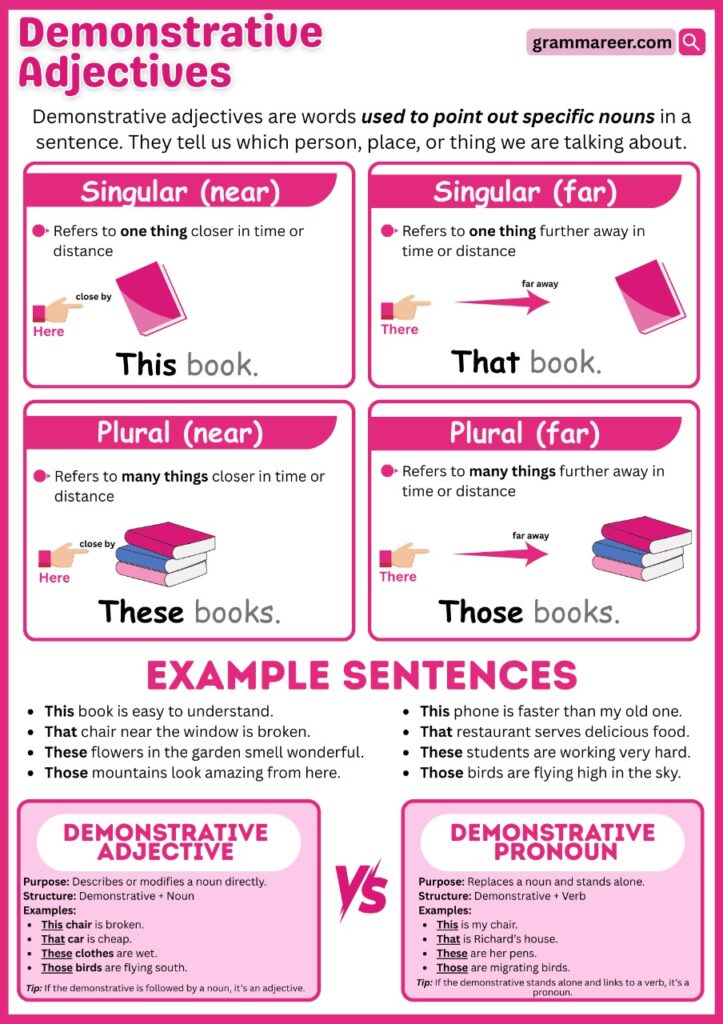
Definition of a Demonstrative Adjective
The word demonstrative simply means “pointing out.” So, a demonstrative adjective is just a word we use to point to a specific person or thing and show exactly which one we’re talking about. Words like this, that, these, and those do this job.
List of demonstrative adjectives
The four main demonstrative adjectives in English are very easy:
- this
- that
- these
- those
Some books and teachers also count ordinal numbers (like first, second, third or 1st, 2nd, 3rd) as demonstrative adjectives, because they also point out the position of something in a list. If we include numbers like these, then the list of demonstrative adjectives could go on forever!
Now, you might be wondering—what about the word none? Is it singular or plural? Don’t worry, we’ll look at that too in a moment.
where do we place a demonstrative adjective in a sentence?
It’s simple: they always come before the noun they describe. Look at these examples:
- This green ball is mine.
- That big lion looks really hungry.
- I want these sparkly sunglasses.
- Those tricky men are up to something.
See how easy that is? Just put this, that, these, or those before the thing you’re talking about, and you’re using demonstrative adjectives correctly.
Rules for Using Demonstrative Adjectives
First, remember this: demonstrative adjectives are adjectives. That means they can only be used with nouns (naming words like book, car, flower) or pronouns. They always come before the noun in the sentence.
- ❌ Wrong: I like beautiful that flower.
- ✅ Right: I like that beautiful flower.
See the difference? The word that comes before the noun (flower). It also comes before any other adjective (like beautiful).
Now here’s a simple rule:
- This and that are used with singular nouns (one thing).
- These and those are used with plural nouns (more than one).
Examples:
- This pen writes smoothly.
- (One pen → singular)
- Maria likes that painting on the wall.
- (One painting → singular)
- These flowers smell amazing.
- (Many flowers → plural)
- The children are playing with those toys.
- (Many toys → plural)
Always check if your noun is one thing or many before choosing the right demonstrative adjective.
But here’s something important: words like this, that, these, and those are not always adjectives. They can also be used as pronouns, adverbs, or even conjunctions. When they are not adjectives, the rules we just learned don’t apply.
Examples:
- I love my phone. Out of all my gadgets, this is the most useful.
- (This is a pronoun—it replaces phone.)
- The food was tasty, but not that spicy.
- (That is an adverb—it changes the meaning of spicy.)
Singular, Plural, Near, or Far?
Demonstrative adjectives are super easy once you know the rule.
- This and that are used with one thing (singular).
- These and those are used with many things (plural).
- This and these show something is near (close to you in space or time).
- That and those show something is far (away from you in space or time).
Examples:
- This plate is hot. (near + one thing)
- Can you see that ranch? (far + one thing)
- These flowers smell nice. (near + many things)
- Don’t go near those dogs. (far + many things)
Now, demonstrative adjectives don’t just tell us where things are in space. They also tell us about time.
- I will always remember this day. (today = near in time)
- Those decisions were tough. (past decisions = far in time)
Demonstrative Adjectives vs Demonstrative Pronouns
Both this, that, these, and those can be demonstrative adjectives or demonstrative pronouns. The difference is actually super easy: it’s all about whether they come with a noun or replace a noun.
- Demonstrative Adjective: It comes before a noun and points to it.
- Example: This book is interesting. (Here, this tells us which book.)
- Demonstrative Pronoun: It stands alone and replaces the noun.
- Example: This is interesting. (Here, this takes the place of the book.)
Think of it like this:
- If the word is helping a noun, it’s an adjective.
- If the word is standing on its own, it’s a pronoun.
Examples of Demonstrative Adjectives in Sentences
- This bag is heavy.
- That car is fast.
- These cookies taste sweet.
- Those trees are tall.
- This phone is new.
- That house looks old.
- These toys are broken.
- Those chairs are comfortable.
- This shirt fits well.
- That movie was amazing.
- These flowers are beautiful.
FAQs
Demonstrative adjectives are words like this, that, these, and those. We use them to point out and identify specific nouns, showing whether something is singular or plural, and near or far. Without them, our sentences would feel vague.
It’s simple: this (singular, near), that (singular, far), these (plural, near), and those (plural, far). They act like signposts in language, helping us guide the listener to exactly which thing we’re talking about.
Yes! They don’t just show distance in space, but also in time. For example, this morning means the present time (near), while those days refers to a time in the past (far).
The difference is in their job. Demonstrative adjectives always come before a noun (this book, those cars). Demonstrative pronouns, on the other hand, stand alone without a noun (This is mine, Those are yours).
Final Thought
As we learned, demonstrative adjectives like this, that, these, and those help us point to nouns clearly by showing number and distance. They make our sentences specific and easy to understand, both in space and time.
Demonstrative Adjectives – Quick Quiz
Results
You May Also Like
All Parts of Speech
Common Noun Definition and Examples
What Is a Predicate Adjective?

